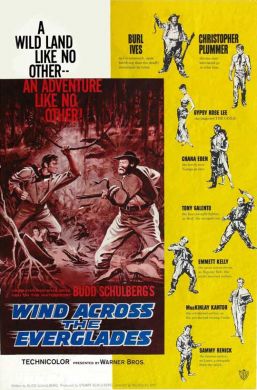
WIND ACROSS THE EVERGLADES
US, 1958, 95 minutes, Colour.
Burl Ives, Christopher Plummer, Chana Eden, Gypsy Rose Lee, Peter Falk.
Directed by Nicholas Ray.
Wind Across the Everglades is a film before its time. While the setting is the early 20th century in the Florida Everglades, the theme is on conservation. There is a focus on preserving the bird life in the Everglades – as well as the role of the officers who preserve wildlife against poachers.
The film was directed by Nicholas Ray who had emerged as a strong director of black and white dramas like They Live By Night in the 1940s. He made the classic 1950s films Johnny Guitar and Rebel Without a Cause. At this time he made Bitter Victory and Party Girl and was about to go more spectacular with Savage Innocents, King of Kings and 55 Days at Peking.
The film is an early one for Christopher Plummer and features unexpected performances by striptease artist, Gypsy Rose Lee. Burl Ives won an Oscar this same year as supporting actor in The Big Country.
A film of beauty – and very relevant for later decades.
1. The title of this film and its indication of themes? What was the purpose of its being made, interest and enjoyment? Adventure, social issues?
2. Comment on the style of the film, its use of colour and music, the atmosphere of Miami, the atmosphere of 1950s and the Everglades? An unusual style for an unusual theme?
3. Hlow important was the conservation theme? The presentation of the issues,. the birds and the animals of the Everglades? The picture of their being exploited, the evil of greed, money? The violence and the cruelty of the men involved in the exploitation, both in the town and in the Everglades? Issues of good and evil as symbolised in this conservation theme?
4. How significant was the atmosphere of violence and cruelty , torture, whippings, cruelty to animals, the atmosphere of poison, death, the final torture, of Walt not being able to sleep? The interrelationship of the beauty of nature and human cruelty?
5. How satisfying was the film as an adventure? Life, characters, difficulties, confrontations of good and evil. heroics?
6. Comment on Walt as the central character and focus of the film? His initial impact on his arrival, his qualities as a person, a teacher and his educational outlook? The incident with the bird and the feathers and what this led to? People’s reaction to him as an outsider? The friendliness of the landlord and the people? The challenge of accepting the job as warden? The background of those who had been killed previously? His falling in love with
Naomi and her love as a motivation for what he did? His hero stature as he began to confront evil?
7. How well portrayed was the setting: Miami, the turn of the century, frontier isolation, people and power? The head of the school Board and his educational role as well as his exploitation? The landlord and his ideals? The attitudes of the people in the town?
8. The contrast with Cottonmouth and his associates? How well delineated was the character of Cottonmouth? Was he a credible villain for the film, a credible character working in the Everglades? His associates as extensions of himself? His cruelty, his striking Walt, tricking him, the murder of the guide? Were there any redeeming features about Cottonmouth’s character?
9. The importance of the confrontation between Walt and Cottonmouth, confrontation of good and evil, symbolised by the conservation theme? The ability to outwit each other? The violence inherent in the conflict?
10. The importance of the return trip, the dangers, the courage on the part of Walt, the mishap for Cottonmouth and his symbolic death?
11. What did Walt achieve in realistic terms and in symbolic terms? The returning hero?
12. What was the overall impact of the film in terms of adventure, social themes, understanding of America and its heritage? The relevance of the film in the 50's, now?